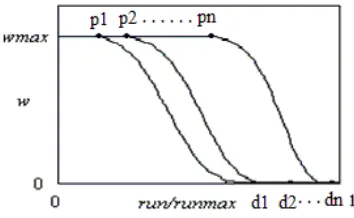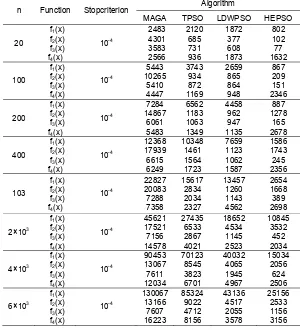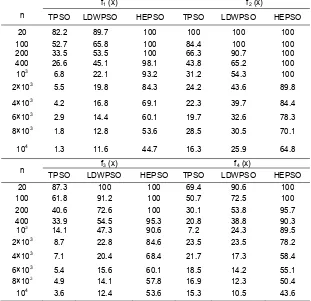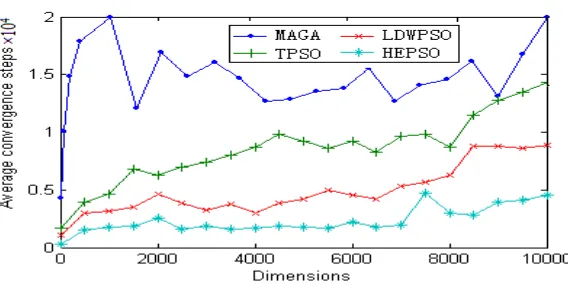DOI: 10.12928/TELKOMNIKA.v12i4.535 1023
Complex Optimization Problems Using Highly Efficient
Particle Swarm Optimizer
Kaiyou Lei1, Changjiu Pu*2 1
Intelligent Software and Software Engineering Laboratory, Southwest University, Chongqing 400715, Chongqing, China
2
Network Center, Chongqing University of Education, Chongqing 400067, Chongqing, China
*Corresponding author, e-mail: [email protected]
Abstract
Many engineering problems are the complex optimization problems with the large numbers of global andlocal optima. Due to its complexity, general particle swarm optimization method inclines towards stagnation phenomena in the later stage of evolution, which leads to premature convergence. Therefore, a highly efficient particle swarm optimizer is proposed in this paper, which employ the dynamic transitionstrategy ofinertia factor, search space boundary andsearchvelocitythresholdbased on individual cognitionin each cycle to plan large-scale space global search and refined local search as a whole according to the fitness change of swarm in optimization process of the engineering problems, and to improve convergence precision, avoid premature problem, economize computational expenses, and obtain global optimum. Several complex benchmark functions are used to testify the new algorithm and the results showed clearly the revised algorithm can rapidly converge at high quality solutions.
Keywords: particle swarm optimizer, complex optimization problem, premature convergence
1. Introduction
As a newly developed population-based computational intelligence algorithm, Particle Swarm Optimization (PSO) was originated as a simulation of simplified social model of birds in a flock [1]-[4]. The PSO algorithm has less parameters, easy implementation, fast convergence speed and other characteristics, is widely used in many fields,such as solving combinatorial optimization, fuzzy control, neural network training, etc. But, the PSO algorithm with other algorithms is also easy to fall into local optimumin fast convergence process, affecting the convergence precision, so how to overcome premature convergence, and improve the accuracy of convergence is always a hot and difficult problem in the research field [5]-[11].
To avoidthe premature problem and speed up the convergence process, thereare many approaches suggested by researchers.According to the research results published in recent years, the improvement of PSO algorithm mainly includes adjusting algorithm parameters, the improvement of topological structure, and mixed with other algorithm, etc [6]-[12].The purpose of improvement strategiesis to balance the global search ability and local search ability of particles, so as to improve the performance of the algorithm.
In this paper, we modified the traditional PSO (TPSO) algorithm with the dynamic transition strategy ofinertia factor, search space boundary andsearchvelocitythresholdbased on individual cognitionin each cycle,whichcan balance the global search ability and local search ability of particles, and has an excellent search performance to lead the search direction in early convergence stage of search process. Experimental results on several complexbenchmark functions demonstrate that this is a verypromisingway to improve the solution quality and rate of success significantly in optimizing complex engineering problems.
Section 2 gives some background knowledge of the PSO algorithm. In section 3, the proposed method and the experimental design are described in detail, and correlative results are given in section 4. Finally, the discussions are drawn in section 5.
2. Back Ground
algorithms, suchas evolutionary algorithms, PSO can solve a variety ofdifficult optimization problems but has shown a fasterconvergence rate than other evolutionary algorithms onsome problems. Anotheradvantage of PSO is that it has very few parameters toadjust, which makes it particularly easy to implement [1]. In PSO, each potential solution is a “bird” in the search space, which is called “particle”. Each particle has a fitness value evaluated by the objective function, and flies over the solution space with a velocity by following the current global best particle and its individual best position. With the directions of best particles, all particles of the swarm can eventually land on the best solution.
The foundation of PSO is based on the hypothesisthat social sharing of information among conspecificsoffers an evolutionary advantage.In the original PSO formula, particle i is denoted as Xi=(xi1,xi2,...,xiD), which represents a potential solution to a problem in D-dimensional space. Each particle maintains a memory of its previous best position Pbest, and a velocity along each dimension, represented as Vi=(vi1,vi2,...,viD). At each iteration, the position of the particle with the best fitness in the search space, designated as g, and the P vector of the current particle are combined to adjust the velocity along each dimension, and that velocity is then used to compute a new position for the particle.
In TPSO, the velocity and position of particle i at (t+1)th iteration are updated as follows:
t
id t gd t
id t id t
id t
id w v c r p x c r p x
v1 1 1 2 2
(1)
1
1
t
id t
id t
id x v
x
(2)
Constants c1 and c2 determine the relative influence of the social and cognition components (learning rates), which often both are set to the same value to give each component equal weight; r1 and r2 are random numbers uniformly distributed in the interval [0,1].A constant, vmax, was used to limit the velocities of the particles. The parameter w, which was introduced as an inertia factor, can dynamically adjust the velocity over time, gradually focusing the PSO into a local search [5].
To speed up the convergence process and avoid the premature problem, Shi proposed the PSO with linearly decrease factor method (LDWPSO) [4],[5]. Suppose wmaxis the maximum of inertia factor, wmin is the minimum of inertia factor, run is the current iterations, runmax is the total iterations. The inertia factor is formulated as:
max min
max max
run run w
w w
w (3)
3. A Highly Efficient Particle Swarm Optimizer (HEPSO)
Due to thecomplexity of a great deal global and local optima,TPSO isrevised as HEPSO by fourdynamic strategies to adapt complex optimizationproblems.
3.1. Dynamic Harmonization Inertia Factor w
First of all, the larger w can enhance global search abilities of PSO, so to explore large-scale search space and rapidly locate the approximate position of global optimum, the smaller w can enhance local search abilities of PSO, particles slow down, deploy refined local search, and obtain global optimum. Secondly, the more difficult the optimization problems are, the more fortified the global search abilities need, once located the approximate position of global optimum, the refined local search will further be strengthen to get global optimum [7]-[12]. Therefore,the wcan harmonize global search and local searchautomatically, avoid premature convergenceand to rapidly gain global optimum.
According to the conclusions above, a new inertia factor decline curve ⑷for PSO is constructed, demonstrated in Figure 1:
n
run run n w
w
max max *exp * ^
Where n is a constant larger than 1, taken 50 as initial value in the paper.Evidently, the inertia factor decline curve of figure 1can forcefully search large-scale global space, and dynamically transform to refined local search, namely global search abilities and local search abilities are harmonized based on the strategy to adapt demand of complex optimizationproblems.
Figure1. Dynamic harmonization w curve Figure 2. Dynamic transformation w curves
3.2.Dynamic Transformation Inertia Factor w Strategy
Global search and local search are two key aspects of PSO based on w. In a given time of search process, it is usually hard to determine, when to end the large-scale global search, and start local search,and gain quick convergence [8]-[10].
In figure2,p1, p2,…, pn are transformation points, d1, d2, …, dn are global convergence points, the algorithm select a transformation point from them, and switch to refined local search to global convergence point. The selection of transformation pointis usually hard. Toconfirm the transformation point,the algorithm is designed to combine iteration times of current global optimum of functions.If the current global optimum is not improved after the search of an interval of definite iterations, the algorithm switch to refined local search with the smaller n, or continue current global search with the current n. Thecomputed equation is defined as:
n r r n esle n n p p
IF i
gd k i
gd
2
1 (5)
Where i k gd
p , i
gd
p are the (i+k)th, ith ,taken values of pgdt respectively, k is an interval of
definite iterations.
3.3.Dynamic Transformation Search Space Boundary Strategy
[image:3.595.314.491.159.268.2]
min
max min
min min max max max min max min min min max max max i i b b r r i b i b b b r r i b i b else b b r r i b i b b b r r i b i b gbest gbest IF 2 1 2 1 2 1 2 1 1 1 1 1 1 (6)3.4. Dynamic Transformation Search Velocity ThresholdStrategy
Many published works based on parameters selection principles pointed out, velocity threshold [vmax(i),vmin(i)] of a particleaffects the convergence precision and speed of algorithm strongly [9]-[11]. Largevmax(i)increases the search region, enhancing global search capability, as well as small vmax(i) decreases the search region, adjusting search direction of each particle frequency. Thus, adynamic transformation search velocitythresholdstrategy is designed based on individual cognition. Thevmax and vmin are the threshold of the swarm in the k iterations, the computed equation is defined as:
min
max min
min min max max max min max min min min max max max i i v v r r i v i v v v r r i v i v else v v r r i v i v v v r r i v i v gbest gbest IF 2 1 2 1 2 1 2 1 1 1 1 1 1 (7)
According to the above methods, TPSO is modified as HEPSO, whichhas the excellent search performance to optimize complex problems. The flow of the HEPSOalgorithm is as follows:
Step1. Set algorithm parameters;
Step2. Randomly initialize the speed and position of each particle;
Step3. Evaluate the fitness of each particle and determine the initial values of the individual and global best positions:
p
idt and tgd
p ;
Step4. Update velocity and position using (1), (2) and (4);
Step5. Evaluate the fitness and determine the current values of the individual and global best positions:
p
idt and tgd
p ;
Step6. Detect the gbesti, gbesti+1 and gbesti+k, to dynamically transformw,search space boundary and velocity threshold using (5), (6)and (7);
Step7. Randomly initialize the speed and position after the k iterations;
Step8. Loop to Step 4 and repeat until a given maximum iteration number is attained or the convergence criterion is satisfied.
4. Computational Experiments 4.1.Testing Functions
To test the HEPSO and compare it with other techniques in the literature, we adopt large variety of benchmark functions [8]-[16], among which most functions are multimodal, abnormal or computational time consuming, and can hardly get favorable results by current optimization algorithm. Due to limited space, we only select four representative functions optimization results to list in the paper.
sin
500 500 )(
1
1
i n
i
i
i x x
x x
f
12 . 5 12 . 5 ] 10 ) 2 cos( 10 [ ) ( 1 2
2
i i
n
i
i x x
x x
f (9)
32 32 20 )) 2 cos( 1 exp( ) 2 1 5 1 exp( 20 ) ( 1 1
3
i n i i n i
i x e x
n x n x f (10) 600 600 1 ) cos( 4000 1 ) ( 1 1 2
4
i
n i n i i i x i x x x
f (11)
4.2. Algorithm Parameter Setting
Parameters used in our algorithm are set to be: learning rate c1=c2=2; w=0.7, wmax =1,
wmin=0.1; maximumiterations runmax=30000; iterations k =1000(300 for f1(x)); population size is 100; speed and position of particles are limited in definition area of functions; take function f1(x), f2(x), f3(x), f4(x) as fitness value. Stop rule is: |fbest─fmin|≤10-4 (fbest and fmin are the global optimum and the current getting optimum). The running environment is: MATLAB7.0, Pentium IV 2GHz CPU, 256M RAM, Win XP OS.
4.3.Experimental Results
[image:5.595.146.449.423.753.2]The testing functions is run50 times based onTPSO, LDWPSO and HEPSO, the comparison of statistical results of 20-1000 dimensions functions are shown in table 1-2, respectively. In addition, the datum of literature [12] (MAGA) is likewise listed in table 1. 1000-10000 dimensions functions are test with MAGA,TPSO, LDWPSO and HEPSO based on the sampling interval 500, each testing function runs 20 times yet, the statistical results are shown in table 1-2 and figure 3-6, respectively.
Table 1. Results of 20-10000 dimensions functions average convergence iterations
n Function Stopcriterion Algorithm
MAGA TPSO LDWPSO HEPSO
20
f1(x)
f2(x)
f3(x)
f4(x)
10-4 2483 4301 3583 2566 2120 685 731 936 1872 377 608 1873 802 102 77 1632 100
f1(x)
f2(x)
f3(x)
f4(x)
10-4 5443 10265 5410 4447 3743 934 872 1169 2659 865 864 948 867 209 151 2346 200
f1(x)
f2(x)
f3(x)
f4(x)
10-4 7284 14867 6061 5483 6562 1183 1063 1349 4458 962 947 1135 887 1278 165 2678 400
f1(x)
f2(x)
f3(x)
f4(x)
10-4 12368 17939 6615 6249 10348 1461 1564 1723 7659 1123 1062 1587 1586 1743 245 2356 103
f1(x)
f2(x)
f3(x)
f4(x)
10-4 22827 20083 7288 7358 15617 2834 2034 2327 13457 1260 1143 4562 2654 1668 389 2698 2×103
f1(x)
f2(x)
f3(x)
f4(x)
10-4 45621 17521 7156 14578 27435 6533 2867 4021 18652 4534 1145 2523 10845 3532 452 2034 4×103
f1(x)
f2(x)
f3(x)
f4(x)
10-4 90453 13067 7611 12034 70123 8545 3823 6701 40032 4065 1945 4967 15034 2056 624 2506 6×103
f1(x)
f2(x)
f3(x)
f4(x)
n Function Stopcriterion Algorithm
MAGA TPSO LDWPSO HEPSO
8×103
f1(x)
f2(x)
f3(x)
f4(x)
10-4
125245 14523
7921 18234
81489 85434 4567 7067
61378 6556 3467 4523
18000 3500
568 3512
104
f1(x)
f2(x)
f3(x)
f4(x)
10-4
198745 19807
7992 27983
130679 14332
6621 15357
85045 8523 4434 13534
[image:6.595.147.449.84.191.2]41289 4668 1745 6123
Table 2.Comparison results of 20-10000 dimensions functions average convergence rate (%)
n
f1 (x) f2 (x)
TPSO LDWPSO HEPSO TPSO LDWPSO HEPSO 20 82.2 89.7 100 100 100 100 100 52.7 65.8 100 84.4 100 100 200 33.5 53.5 100 66.3 90.7 100 400 26.6 45.1 98.1 43.8 65.2 100 103 6.8 22.1 93.2 31.2 54.3 100 2×103 5.5 19.8 84.3 24.2 43.6 89.8
4×103 4.2 16.8 69.1 22.3 39.7 84.4 6×103 2.9 14.4 60.1 19.7 32.6 78.3
8×103 1.8 12.8 53.6 28.5 30.5 70.1
104 1.3 11.6 44.7 16.3 25.9 64.8 n f3 (x) f4 (x)
TPSO LDWPSO HEPSO TPSO LDWPSO HEPSO 20 87.3 100 100 69.4 90.6 100 100 61.8 91.2 100 50.7 72.5 100 200 40.6 72.6 100 30.1 53.8 95.7 400 33.9 54.5 95.3 20.8 38.8 90.3 103 14.1 47.3 90.6 7.2 24.3 89.5 2×103 8.7 22.8 84.6 23.5 23.5 78.2 4×103 7.1 20.4 68.4 21.7 17.3 58.4 6×103 5.4 15.6 60.1 18.5 14.2 55.1 8×103 4.9 14.1 57.8 16.9 12.3 50.4
[image:6.595.142.453.227.528.2]104 3.6 12.4 53.6 15.3 10.5 43.6
Figure 4. Theconvergence results of f2(x)
Figure 5.Theconvergence results of f3(x)
Figure 6. Theconvergence results of f4(x)
5. Conclusion
The experimental results of Table 1-2 can deduce that the effectiveness of the HEPSOalgorithm based on individual cognitionis validated,which guide particles to search in the more effective areathrough dynamic adjustmentthe search space, provide stable convergence, resulting in higher success rate and accuracy of convergence. The algorithm runs classical PSO only, so to keeps its simple and easy characteristic.
[image:7.595.160.442.447.584.2]has rapid convergence speed and can avoid premature.In addition, it can easily be applied to large and more complex practical multi-objective optimization problems.
Acknowledgements
This work is supported by Key Project of Chinese Ministry of Education (104262).
References
[1] J. Kennedy, RC. Eberhart. Particle swarm optimization. Proceedings of IEEE International Conference on Neural Networks. Piscataway, USA. 1995: 1942-1948.
[2] X. Hu, RC. Eberhart, YH. Shi. Engineering optimization with particle swarm. Proceedings of the IEEE Swarm Intelligence Symposium. Indianapolis, Indiana. 2003: 53-57.
[3] Clerc, J. Kennedy. The particle swarm: explosion, stability, and convergence in a multi-dimensional complex space. IEEE Transactions on Evolutionary Computation. 2002; 6(1): 58-73.
[4] YH. Shi, RC. Eberhart. Empirical study of particle swarm optimization. Proceedings of the IEEE Congress on Evolutionary Computation. Piscataway, USA. 1999: 1945-1950.
[5] YH. Shi, RC. Eberhart. A modified particle swarm optimizer. Proceedings of the IEEE Congress on Evolutionary Computation. New York. 1998: 69-73.
[6] Chen D, Wang GF, Chen ZY. The inertia weight self-adapting in PSO. Proceedings of the Seventh world Congress on intelligent Control and automation. New York. 2008: 5313-5316.
[7] Angeline, P. Using selection to improve particle swarm optimization. Proceedings of IJCNN’99. Washington, USA. 1999: 84-89.
[8] Kaiyou Lei, Yuhui Qiu, Yi He. A new adaptive well-chosen inertia weight strategy to automatically harmonize global and local search ability in particle swarm optimization. Proceedings of 1st International Symposium on Systems and Control in Aerospace and Astronautics.HarbinChina. 2006: 342-346.
[9] Chen Bing-rui, Feng Xia-ting. Particle swarm optimization with contracted ranges of both search space and velocity. Journal of Northeastern University (Natural Science). 2005; 5: 488-491.
[10] Y.Shi, RC. Eberhart. Parameter selection in particle swarmoptimization. Proceedings of theSeventh Annual Conference on Evolutionary Programming. New York. 1998; 1447: 591–600.
[11] Wang Jun-wei, Wang Ding-wei. Experiments and analysis on inertia weight in particle swarm optimization. Journal of Systems Engineering. 2005; 2: 184-198.
[12] Zhong Wei-cai, Xue Ming-zhi, et al. Multi-agent genetic algorithm for super-high dimension complex functions optimization. Natural Science Progress. 2003; 10: 1078-1083.
[13] Li Bing-yu, Xiao Yun-shi, Wang Lei. A hybrid particle swarm optimization algorithm for solving complex functions with high dimensions. Information and Control. 2004; 1: 27-30.
[14] Hui wang, Zhijian Wu, S Rahnmayan. Enhanced opposition based differential evolution for solving high-dimensional continuous optimization problems. Soft Compting-A Fusion of Foundations, Methodologies and Applications. 2011; 15(11): 2127-2140.
[15] Li Wen-feng, Liang Xiao-lei, Zhang Yu. Research on PSO with clusters and heterogeneity. Acta Electronica Sinica. 2012; 40(11): 2194-2199.



